UB Trabajo Final de Máster (PDF)
File information
Title: Tesis Final.pdf
This PDF 1.3 document has been generated by Preview / Mac OS X 10.11.2 Quartz PDFContext, and has been sent on pdf-archive.com on 18/09/2016 at 19:25, from IP address 92.186.x.x.
The current document download page has been viewed 1099 times.
File size: 943.91 KB (108 pages).
Privacy: public file
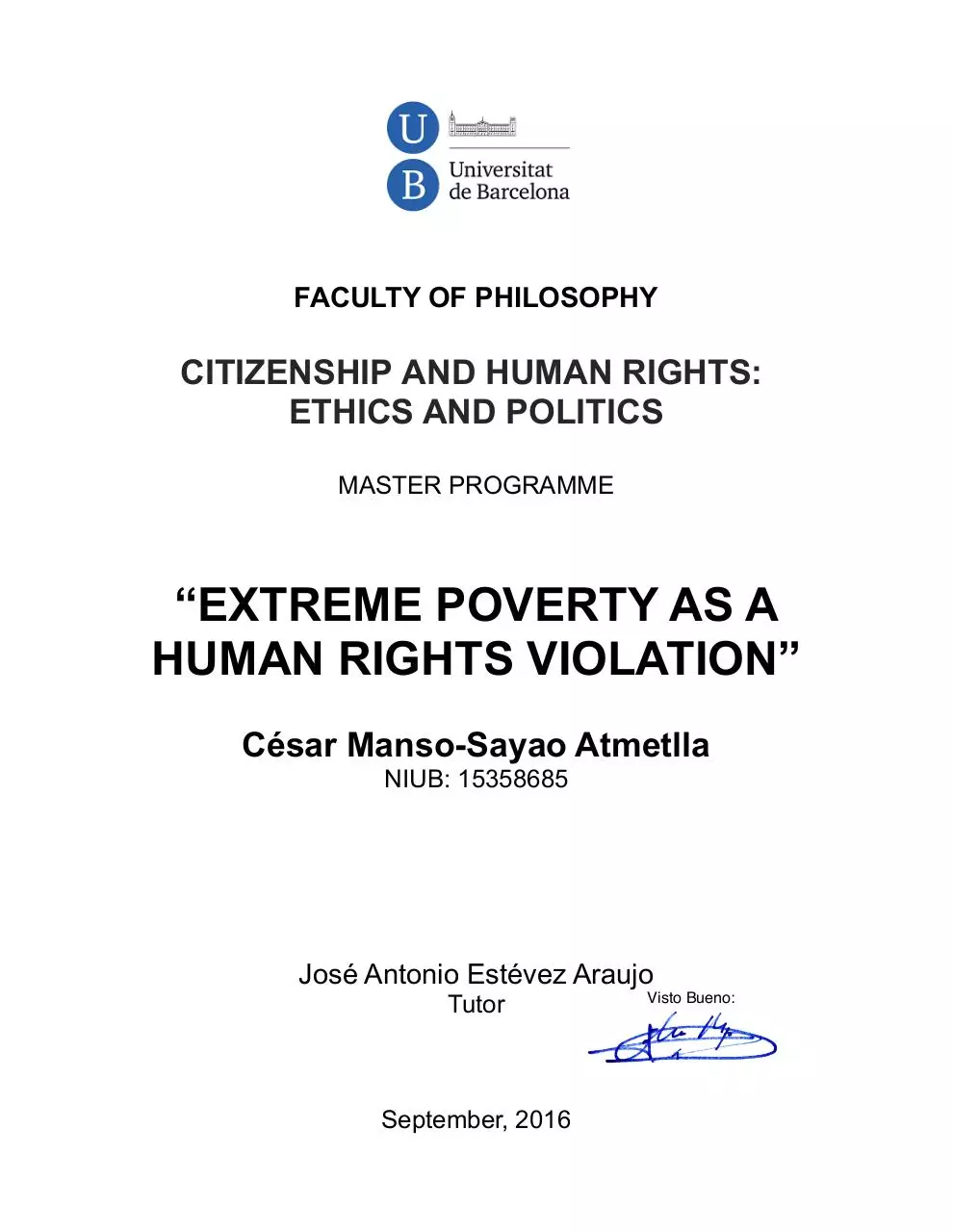
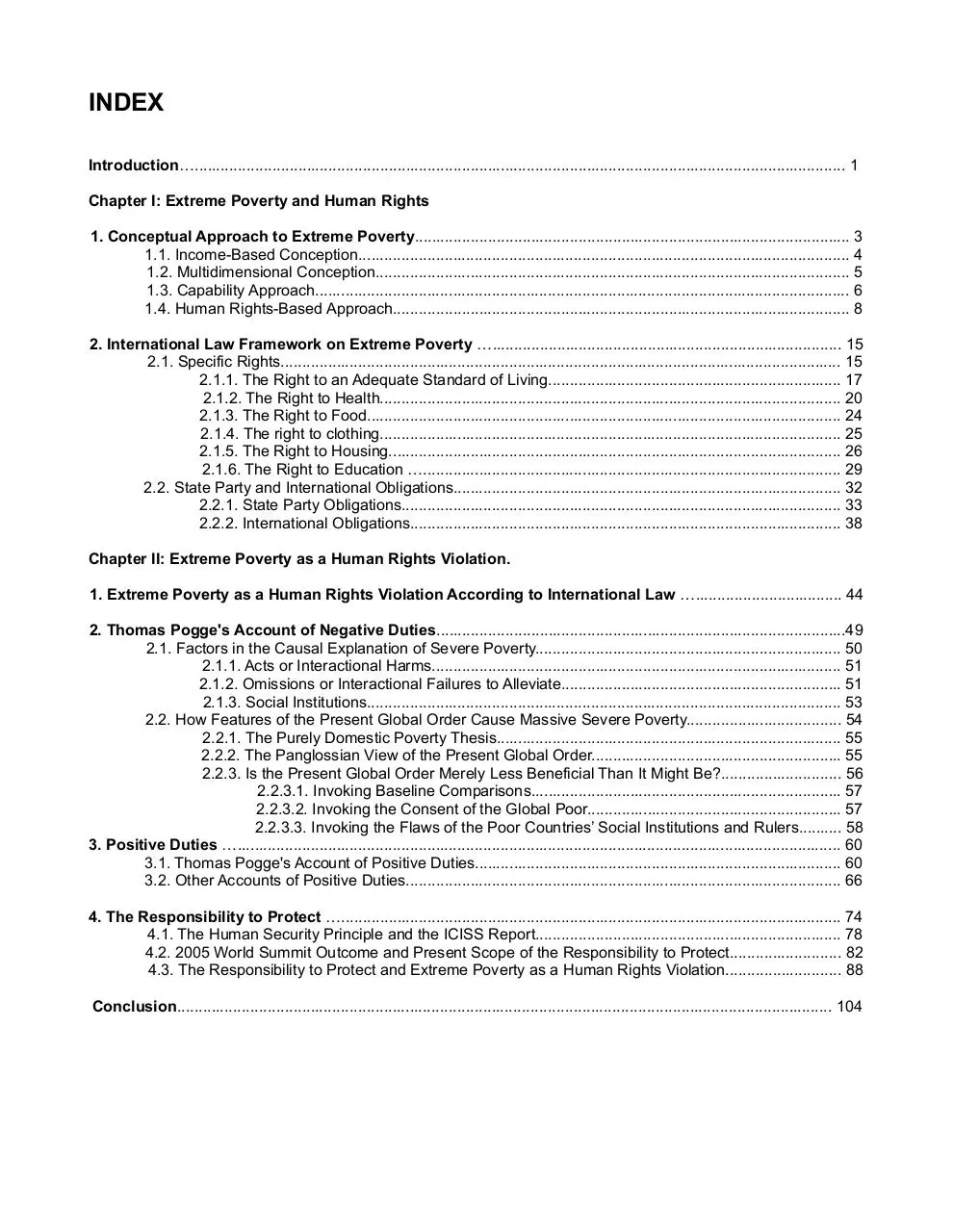
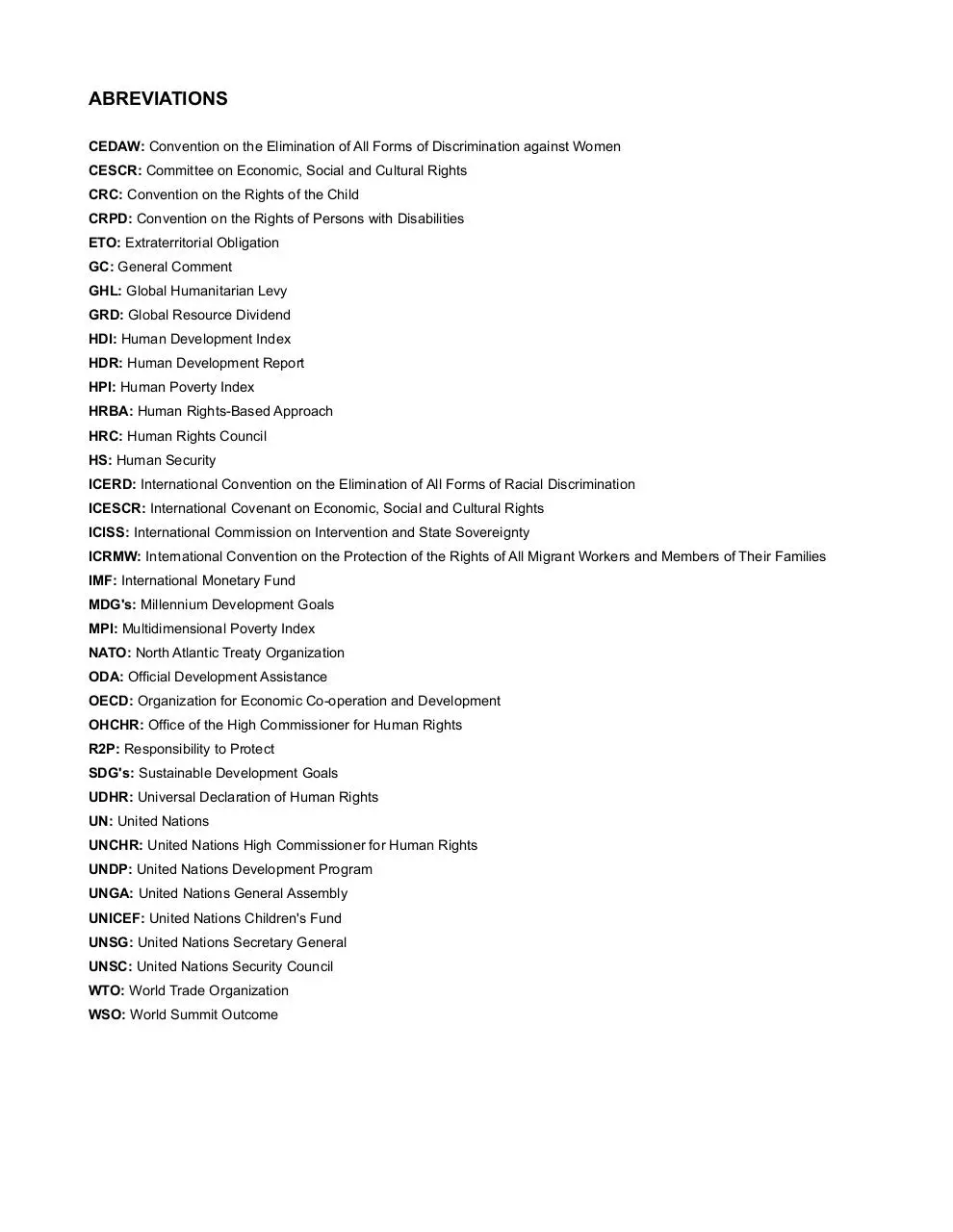
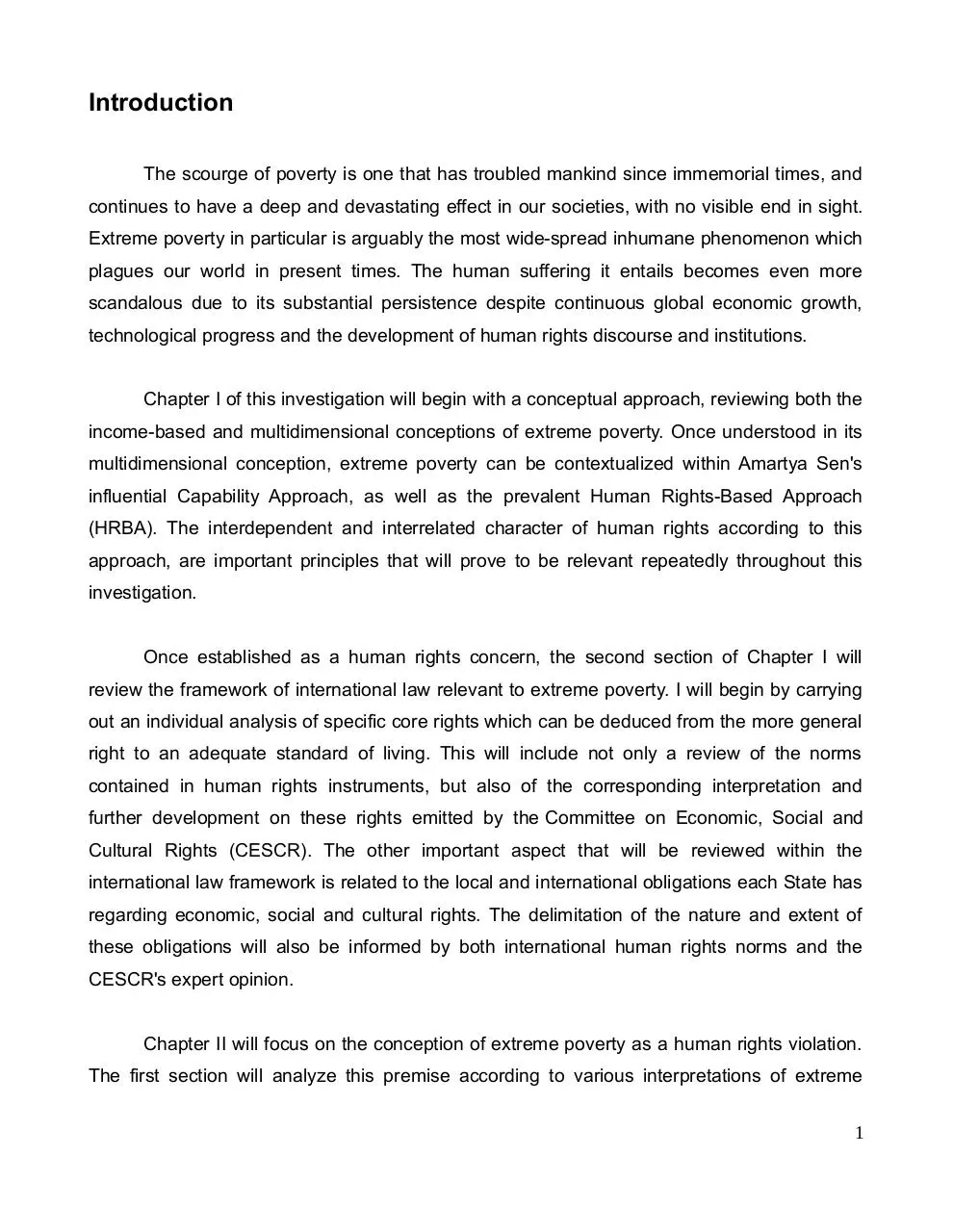

File preview
FACULTY OF PHILOSOPHY
CITIZENSHIP AND HUMAN RIGHTS:
ETHICS AND POLITICS
MASTER PROGRAMME
“EXTREME POVERTY AS A
HUMAN RIGHTS VIOLATION”
César Manso-Sayao Atmetlla
NIUB: 15358685
José Antonio Estévez Araujo
Tutor
September, 2016
Visto Bueno:
INDEX
Introduction…....................................................................................................................................................... 1
Chapter I: Extreme Poverty and Human Rights
1. Conceptual Approach to Extreme Poverty..................................................................................................... 3
1.1. Income-Based Conception.................................................................................................................. 4
1.2. Multidimensional Conception.............................................................................................................. 5
1.3. Capability Approach............................................................................................................................ 6
1.4. Human Rights-Based Approach.......................................................................................................... 8
2. International Law Framework on Extreme Poverty …................................................................................. 15
2.1. Specific Rights.................................................................................................................................. 15
2.1.1. The Right to an Adequate Standard of Living.................................................................... 17
2.1.2. The Right to Health........................................................................................................... 20
2.1.3. The Right to Food.............................................................................................................. 24
2.1.4. The right to clothing........................................................................................................... 25
2.1.5. The Right to Housing......................................................................................................... 26
2.1.6. The Right to Education …................................................................................................. 29
2.2. State Party and International Obligations.......................................................................................... 32
2.2.1. State Party Obligations...................................................................................................... 33
2.2.2. International Obligations.................................................................................................... 38
Chapter II: Extreme Poverty as a Human Rights Violation.
1. Extreme Poverty as a Human Rights Violation According to International Law ….................................. 44
2. Thomas Pogge's Account of Negative Duties...............................................................................................49
2.1. Factors in the Causal Explanation of Severe Poverty....................................................................... 50
2.1.1. Acts or Interactional Harms............................................................................................... 51
2.1.2. Omissions or Interactional Failures to Alleviate................................................................. 51
2.1.3. Social Institutions.............................................................................................................. 53
2.2. How Features of the Present Global Order Cause Massive Severe Poverty.................................... 54
2.2.1. The Purely Domestic Poverty Thesis................................................................................ 55
2.2.2. The Panglossian View of the Present Global Order.......................................................... 55
2.2.3. Is the Present Global Order Merely Less Beneficial Than It Might Be?............................ 56
2.2.3.1. Invoking Baseline Comparisons........................................................................ 57
2.2.3.2. Invoking the Consent of the Global Poor........................................................... 57
2.2.3.3. Invoking the Flaws of the Poor Countries’ Social Institutions and Rulers.......... 58
3. Positive Duties …............................................................................................................................................ 60
3.1. Thomas Pogge's Account of Positive Duties..................................................................................... 60
3.2. Other Accounts of Positive Duties..................................................................................................... 66
4. The Responsibility to Protect ….................................................................................................................... 74
4.1. The Human Security Principle and the ICISS Report....................................................................... 78
4.2. 2005 World Summit Outcome and Present Scope of the Responsibility to Protect.......................... 82
4.3. The Responsibility to Protect and Extreme Poverty as a Human Rights Violation........................... 88
Conclusion........................................................................................................................................................ 104
ABREVIATIONS
CEDAW: Convention on the Elimination of All Forms of Discrimination against Women
CESCR: Committee on Economic, Social and Cultural Rights
CRC: Convention on the Rights of the Child
CRPD: Convention on the Rights of Persons with Disabilities
ETO: Extraterritorial Obligation
GC: General Comment
GHL: Global Humanitarian Levy
GRD: Global Resource Dividend
HDI: Human Development Index
HDR: Human Development Report
HPI: Human Poverty Index
HRBA: Human Rights-Based Approach
HRC: Human Rights Council
HS: Human Security
ICERD: International Convention on the Elimination of All Forms of Racial Discrimination
ICESCR: International Covenant on Economic, Social and Cultural Rights
ICISS: International Commission on Intervention and State Sovereignty
ICRMW: International Convention on the Protection of the Rights of All Migrant Workers and Members of Their Families
IMF: International Monetary Fund
MDG's: Millennium Development Goals
MPI: Multidimensional Poverty Index
NATO: North Atlantic Treaty Organization
ODA: Official Development Assistance
OECD: Organization for Economic Co-operation and Development
OHCHR: Office of the High Commissioner for Human Rights
R2P: Responsibility to Protect
SDG's: Sustainable Development Goals
UDHR: Universal Declaration of Human Rights
UN: United Nations
UNCHR: United Nations High Commissioner for Human Rights
UNDP: United Nations Development Program
UNGA: United Nations General Assembly
UNICEF: United Nations Children's Fund
UNSG: United Nations Secretary General
UNSC: United Nations Security Council
WTO: World Trade Organization
WSO: World Summit Outcome
Introduction
The scourge of poverty is one that has troubled mankind since immemorial times, and
continues to have a deep and devastating effect in our societies, with no visible end in sight.
Extreme poverty in particular is arguably the most wide-spread inhumane phenomenon which
plagues our world in present times. The human suffering it entails becomes even more
scandalous due to its substantial persistence despite continuous global economic growth,
technological progress and the development of human rights discourse and institutions.
Chapter I of this investigation will begin with a conceptual approach, reviewing both the
income-based and multidimensional conceptions of extreme poverty. Once understood in its
multidimensional conception, extreme poverty can be contextualized within Amartya Sen's
influential Capability Approach, as well as the prevalent Human Rights-Based Approach
(HRBA). The interdependent and interrelated character of human rights according to this
approach, are important principles that will prove to be relevant repeatedly throughout this
investigation.
Once established as a human rights concern, the second section of Chapter I will
review the framework of international law relevant to extreme poverty. I will begin by carrying
out an individual analysis of specific core rights which can be deduced from the more general
right to an adequate standard of living. This will include not only a review of the norms
contained in human rights instruments, but also of the corresponding interpretation and
further development on these rights emitted by the Committee on Economic, Social and
Cultural Rights (CESCR). The other important aspect that will be reviewed within the
international law framework is related to the local and international obligations each State has
regarding economic, social and cultural rights. The delimitation of the nature and extent of
these obligations will also be informed by both international human rights norms and the
CESCR's expert opinion.
Chapter II will focus on the conception of extreme poverty as a human rights violation.
The first section will analyze this premise according to various interpretations of extreme
1
poverty within the official human rights discourse at the United Nations (UN) level, where
extreme poverty is not explicitly framed as a human rights violation per se, despite certain
ambiguity which could implicitly point in this direction.
The second section will review Thomas Pogge's account of extreme poverty as a
human rights violation. This thesis is based on a minimal account of human rights, central to
which is the conception of a negative right to be free from severe poverty, and the negative
duties this entails. Pogge's view also establishes the role the institutional global order plays in
the creation and maintenance of severe deprivation. In the third section I will analyze the
positive duties Pogge proposes in correlation with this negative right, alongside other
influential accounts of positive duties related to extreme poverty, such as those contained in
Amartya Sen's capability approach and Henry Shue's conception of basic rights.
The fourth and last section of this chapter will focus on the Responsibility to Protect
(R2P) principle, which has become the prevailing paradigm in the realm of international law
regarding humanitarian intervention. By reviewing the initial conception of R2P as formulated
by the International Commission on Intervention and State Sovereignty (ICISS), which was
based on the Human Security (HS) paradigm, I will offer a critical assessment of the R2P's
narrow scope, which is currently limited to genocide, war crimes, ethnic cleansing and crimes
against humanity. Drawing on the various conceptions of extreme poverty as a human rights
violation developed during the investigation, I will make a case for the broadening of R2P's
scope to include extreme poverty among the mass atrocities which can trigger its activation
among the international community. This is a novel idea, on which there is very little literature
at hand. However, in my opinion, it offers a provocative and promising area for further
discussion, to which I hope this investigation makes some sort of contribution.
2
Chapter I: Extreme Poverty and Human Rights.
1. Conceptual Approach to Extreme Poverty.
As I have stated in my opening remarks, poverty is arguably the most wide-spread
inhumane phenomenon which plagues our world. In the words of Louise Arbour, the United
Nations High Commissioner for Human Rights (UNHCHR), it “is the gravest human rights
challenge facing the world today.” 1 Some of the statistically quantifiable repercussions of this
global phenomenon will be mentioned throughout this investigation. However, the magnitude
of human suffering it entails is incommensurable, and projects a dark shadow on any degree
of human development and progress experienced in our modern times. As the Office of the
High Commissioner for Human Rights (OHCHR) has also stated, “in a world characterized by
an unprecedented level of economic development, technological means and financial
resources, that millions of persons are living in extreme poverty is a moral outrage.” 2
Poverty is not only problematic in its empirical form and real life consequences, but
also on a conceptual level. The etymological challenges present in any subject matter seem
to be magnified when it comes to the notion of poverty. Paul Spicker eloquently articulates
this in the following terms:
“Debates on poverty have been bedevilled by an artificial academic formalism,
which has insisted that there must be an agreed core of meaning, that
contradictory examples showed that certain uses were ‘right’ while others were
‘wrong’, and that disagreement was based not in a difference of interpretation or
the focus of concern, but in a failure to understand the true nature of the
problem. Poverty does not, however, have a single meaning. It has a series of
meanings, linked through a series of resemblances. […] In the social sciences
poverty is commonly understood in at least twelve discrete senses. The senses
overlap; many of the main protagonists in the debate take two or three positions
simultaneously. They are discrete because they can be logically separated, so
that circumstances which apply in one sense do not necessarily apply in
others.”3
1
2
3
United Nations High Commissioner for Human Rights. (2006). Principles and Guidelines for a Human Rights
Approach to Poverty Reduction Strategies, HR/PUB/06/12. Foreword. Recovered from:
http://www.ohchr.org/Documents/Publications/PovertyStrategiesen.pdf
Office of the High Commissioner for Human Rights. (2012). Guiding Principles on Extreme Poverty and Human
Rights, A/HRC/21/39, Preface, p. 2. Recovered from:
http://www.ohchr.org/Documents/Publications/OHCHR_ExtremePovertyandHumanRights_EN.pdf
Spicker, Paul. (2007). “Definitions of Poverty: Twelve Clusters of Meaning” in Poverty: An International Glossary, pp.
3
1.1. Income-Based Conception.
Despite this insurmountable hurdle, there are some commonly shared beacons which
we can look to in order to begin the conceptual approach to poverty relevant for the purpose
of this investigation. One first step is to differentiate between what is understood as absolute
poverty and relative poverty. The term “absolute poverty” was initially coined by the UN as “a
condition characterized by severe deprivation of basic human needs, including food, safe
drinking water, sanitation facilities, health, shelter, education and information. It depends not
only on income but also on access to social services.” 4 However, what is commonly referred
to nowadays as absolute poverty, is an income-based international poverty line set by the
World Bank, which has recently been updated in 2015, from US$1.25 a day based on 2005
prices, to US$1.90 a day with relation to 2011 prices. 5
The idea behind this threshold is to set a value that remains constant among all
countries, under the assumption that minimal survival implies essentially the same amount of
resources in anyone of them, and that there must be an equal standard to enable meaningful
comparisons regarding policies and progress. This is precisely the indicator that was used to
evaluate data concerning the Millennium Development Goals (MDG's), and is now used to
measure progress towards the Sustainable Development Goals (SDG's). According to the
most recent estimates, in 2012, 896 million people lived at or below $1.90 a day (down from
1.95 billion in 1990), which means 12.7% of the world’s population (down from 37% in 1990). 6
Relative poverty, on the other hand, has to do with the minimum level of income
required to adequately fulfil basic needs in a specific country. Therefore, besides the
international poverty line, each country has their own poverty line also set by the World Bank,
which takes into account the particular level of income and costs within each state. This
indicator is more relevant to asses issues in developed countries, where the economic
4
5
6
229–230. Recovered from: http://dds.cepal.org/infancia/guide-to-estimating-child-poverty/bibliografia/capituloI/Spicker%20Paul%20(1999)%20Definitions%20of%20poverty%20eleven%20clusters%20of%20meaning.pdf
United Nations. (1995). Programme of Action of the World Summit for Social Development, para. 19. Recovered from:
http://www.un-documents.net/poa-wssd.htm
Cruz, Marcio et al. (2015). Ending Extreme Poverty and Sharing Prosperity: Progress and Policies. World Bank Policy
Research Note, p. 5. Recovered from:
http://pubdocs.worldbank.org/en/109701443800596288/PRN03Oct2015TwinGoals.pdf
http://www.worldbank.org/en/topic/poverty/overview
4
deprivation problem is not so much the effects of poverty in any absolute form, but has more
to do with inequality and the contrast between the lives of the poor and the average living
standards in their specific social and economic context. National poverty lines are widely used
by a variety of United Nations organizations, including the United Nations Development
Program (UNDP), the United Nations Children's Fund (UNICEF), and the Organization for
Economic Co-operation and Development (OECD).
This investigation, however, will focus on absolute poverty. Despite the fact that affluent
countries have considerable populations who suffer social disadvantage and exclusion due to
economic inequality, as Thomas Pogge explains, relative poverty would only be relevant in his
analysis “in those exceedingly rare instances where such people are so poor in the absolute
sense that their access to basic necessities is as insecure as that of the very poor in the
developing world.”7 I justify my scope under the same premise.
Absolute poverty is a concept mainly used in the context of distinguishing it from
relative poverty. However the indicators which stem from it, like the international poverty line,
are used to measure what is commonly referred to as extreme poverty. This is the terminology
which is most frequently used, among other synonyms like acute poverty, severe poverty,
destitution or penury.
1.2. Multidimensional Conception.
However, the international poverty line is by no means the only conceptual approach to
this phenomenon. It is commonly criticized due to being narrowly income-based, and
therefore not taking into account other important services and development indicators. From
the income-based perspective, the prevailing notion is that “while poverty is widely accepted
as a multidimensional phenomenon, there is no universal consensus on whether and how to
aggregate multiple dimensions of poverty into a single welfare measure,”
8
while recognizing
that “multidimensional poverty measures may provide useful complementary perspectives on
7
8
Pogge, Thomas (Ed.) (2007). Freedom from Poverty as a Human Right. Who Owes What to the Very Poor? Oxford:
Unesco, p. 2. Recovered from: http://unesdoc.unesco.org/images/0015/001518/151826e.pdf
Cruz, Marcio et al., (2015). Op. Cit., p. 21.
5
the dynamics of poverty over time”. 9 Among these, the most influential measure is the
Multidimensional Poverty Index (MPI), which was developed by the UNDP and the Oxford
Poverty & Human Development Initiative in 2010, and substituted the previous Human
Poverty Index (HPI).
The MPI, as its name suggests, goes beyond income data. It assesses poverty at the
individual level, and takes into account ten weighted factors, classified in three categories:
education, health and living standards. The ten specific factors mentioned are the following:
nutrition, child mortality, years of schooling, school attendance, cooking fuel, improved
sanitation, safe drinking water, electricity, flooring and assets. 10 Deprivation on one third or
more of ten weighted indicators will classify the person as MPI poor. The index is designed to
measure acute poverty (the term commonly used in MPI literature), which refers to two main
characteristics:
“First, it includes people living under conditions where they do not reach the
minimum internationally agreed standards in indicators of basic functionings,
such as being well nourished, being educated or drinking clean water. Second, it
refers to people living under conditions where they do not reach the minimum
standards in several aspects at the same time.” 11
1.3. Capability Approach.
The term functionings in the previous quote, is a reference to economist Amartya Sen's
influential capability approach. Sen was at the forefront in the development of the
multidimensional poverty paradigm, and his work alongside Mahbub ul Haq was instrumental
in developing the Human Development Index (HDI). It was precisely the three broad
dimensions of health, education and standard of living initially established by the HDI, which
the MPI built upon. However the HDI uses only single indicators for each category of poverty,
while the MPI, instead, includes the multiple indicators previously enumerated. As a
consequence, despite its limitations with regards to the range of indicators, the HDI is still
9 Ibid., p. 20.
10 Emma Santos, Maria and Alkire, Sabina. (2015), “Training Material for Producing National Human Development
Reports” in MPI: Construction & Analysis, p. 5. Recovered from: http://www.ophi.org.uk/wp-content/uploads/MPIPrimer.pdf
11 Ibid., p. 3.
6
Download UB Trabajo Final de Máster
UB Trabajo Final de Máster.pdf (PDF, 943.91 KB)
Download PDF
Share this file on social networks
Link to this page
Permanent link
Use the permanent link to the download page to share your document on Facebook, Twitter, LinkedIn, or directly with a contact by e-Mail, Messenger, Whatsapp, Line..
Short link
Use the short link to share your document on Twitter or by text message (SMS)
HTML Code
Copy the following HTML code to share your document on a Website or Blog
QR Code to this page
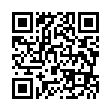
This file has been shared publicly by a user of PDF Archive.
Document ID: 0000484268.